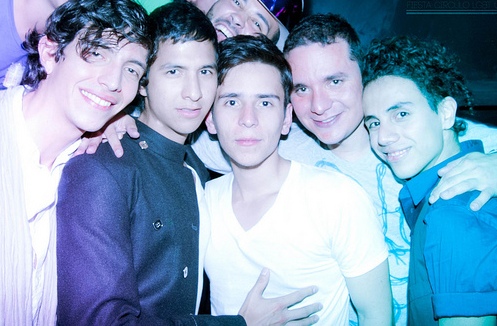In another recent City-by-the-Bay connection, Lima’s new LGBT center, Epicentro (Av. Larco 841, second floor. Tel: 310-601-7798 or 011-511-255-7486. www.epicentro.org.pe), was opened in 2008 with assistance from the San Francisco AIDS Foundation (as well as the Pangaea Global AIDS Foundation). Epicentro is conveniently set right in Miraflores, and offers a very impressive array of services (from HIV testing to yoga to foreign language courses, as well as hosting parties, movies and karaoke nights) for Lima’s not-always-able-to-be-out gay community. Importantly for visitors to town, the organization also prints a small but very helpful and regularly updated free gay guide to Peru, listing gay bars, clubs and saunas (and also gay-friendly hotels and restaurants), not just in Lima but throughout the country.
Though Epicentro is focused solely on improving the lives of Peru’s gay individuals, Lima also has two more politically-charged LGBT groups, both of which periodically hold controversial gay rights demonstrations. In May, the group La Red Peruana de Masculinidades (The Peruvian Red Masculinities, rpmasc.blogspot.com) held a public action in Plaza San Martín called “Hand in Hand Against Homophobia”, in commemoration of the International Day Against Homophobia. Thankfully this event went down without incident, since tensions were heightened after a similar event in February at Plaza de Aromas, “Kisses Against Homophobia” (sponsored by the nearly three-decade-old MHOL, or Movement Homosexual de Lima, www.mhol.org.pe) ended in police violence against the demonstrators. “We, a group of lesbian, gay and bisexual couples, were walking through the Plaza de Aromas and kissing, when the police arrived and began hitting us and using pepper spray,” activist Veronica Ferrari told Peru’s Canal N. “They never gave any reasons for their actions.” Shortly afterward, both Lima’s mayor Susana Villa ran and then-president Alan Garcia spoke out against the violence. “They can conduct all the demonstrations they want, as along as they respect the rules,” stressed Villarán,” because this type of expression is a constitutional right.”
Indeed, gay rights (especially same-sex marriage, which is virulently opposed by the locally powerful Catholic Church) have become an almost omnipresent talking point for the voracious Peruvian media. And as mentioned, they’ve also become an important part of Peruvian politics, with nearly every candidate in this year’s presidential election cycle forced to take a stand on the issue. Most tried to straddle the middle, expressing support of something less than full marriage rights. Keiko Fujimori, one of two candidates who made it through the hard-fought first round for the June 5 run-off, and who at press time is pulling ahead and looks poised for victory, has said she supports civil unions. (Fujimori, U.S- educated and just 36 years old, is the daughter of embattled former Peruvian president Alberto Fujimori. In 1994 she became the youngest ever first lady of Peru, appointed by her father after he stripped his estranged wife of the title.)
And though he was eliminated from the race in the first round of this year’s election, if former president Alejandro Toledo been elected again this year, his running mate, openly gay Peruvian congressman Carlos Bruce, would have been the country’s first out vice-president. Toledo and Bruce’s party accordingly pledged full support to same-sex civil unions if elected — which may or may not have had something to do with their decline in popularity after having led in early polls.
The only major candidate in the first round of elections who did not support some form of gay rights was Fujimori’s run-off opponent, Ollanta Humala. In this, his second presidential bid, leftist Humala had to backtrack from issues that got him into trouble in his 2006 run-off against Alan García. One was his connection to controversial Venezuelan president Hugo Chávez, another his own mother’s highly inflammatory anti-gay rhetoric. “I bet you that … by shooting two homosexuals, there wouldn’t be so much immorality in the streets,” Humala’s madre told the newspaper Expreso.
Humala refused to condemn the quote at the time, and such was the stuff that used to send gay travelers looking the other way when considering a trip to Peru. But as an example of how quickly the climate is changing here, just a few short years later in 2009, when Humala swung through the northern Peruvian jungle city of Tarapoto, he was actually cheered by members of the town’s surprisingly large gay community, and even shared a televised embrace with local trans celebrity Thalia Tarapotina. “I do not make any discrimination or distinction,” he said in an accompanying speech. “All people must have the same opportunities.”
To help you put together the perfect visit to the Peruvian capital (and beyond to the country’s myriad anthropologic and natural wonders, should you choose), Lima Tours (011-511-619-6900. www.limatours.com.pe) is hands down the preeminent choice. As the company who put together the first LGBT tours to Peru with Hanns Ebensten back in the 1970s, Lima Tours has years of experience in the field, is personally tapped into the quick-evolving local scene, and can tailor your visit to be as gay-geared as you like.
(This article originally appeared in the May 2012 print issue of Passport Magazine.)






